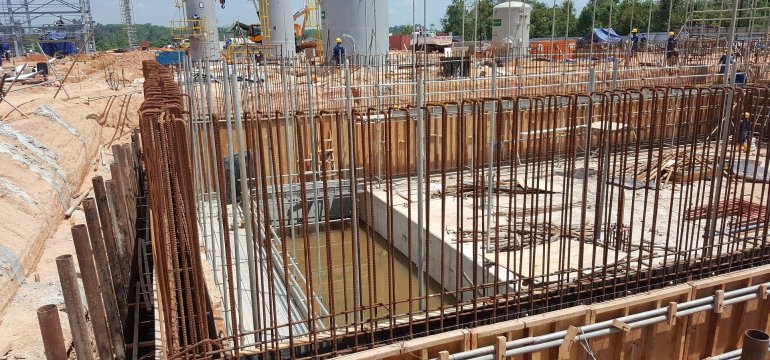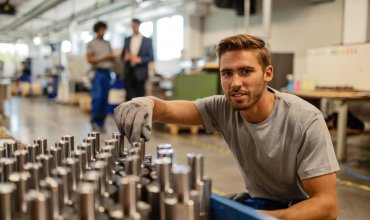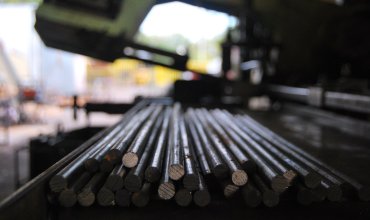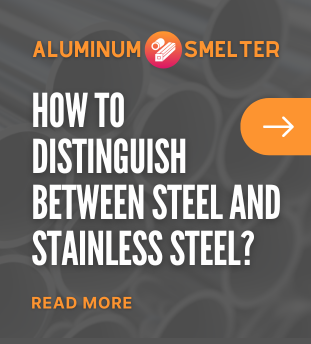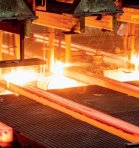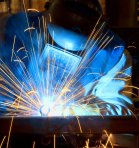Steel in construction plays a key role, becoming an integral part of modern architecture and construction. Thanks to its unique properties, such as high strength, ductility and durability, steel in construction allows the creation of both aesthetic and functional structures. From skyscrapers and bridges to industrial halls and single-family homes, steel is a material that remains in the spotlight of engineers and architects around the world, including Poland. In this article, we take a look at the main applications of steel in the construction industry, discovering what benefits its use brings and what challenges the construction industry may face.
Steel in the load-bearing structures of buildings
Steel in construction is commonly used as the main structural material in load-bearing structures. Load-bearing structures require materials with high strength, the ability to carry heavy loads and longevity. Steel's performance, due to its exceptional mechanical properties, makes it an ideal choice for use in building framing.
Steel load-bearing structures can take various forms, including steel frames, girders and beams. Steel framing is characterized by quick and relatively simple assembly, which reduces construction time and labor costs. In addition, steel has the ability to recover from deformation, making steel structures more resistant to deformation from extraordinary conditions such as earthquakes.
The use of steel in load-bearing construction also has many environmental advantages. Modern steel production processes allow steel to be recycled, which reduces construction waste and reduces the carbon footprint. In Poland, steel recycling is highly developed, which further supports sustainability in the construction industry.
Steel structures also make it possible to create large, open interior spaces without the need for numerous columns, which is extremely beneficial for architectural projects such as industrial halls, airplane hangars, and shopping malls. The strength of steel makes it possible to build taller and more complex structures that can withstand a variety of loading conditions, both static and dynamic.
Combining the advantages of steel in structural construction with modern building technologies makes it possible to create more efficient, safer and more durable buildings. This makes steel in structural construction the foundation of modern architecture, enabling the construction of reliable structural frameworks that will stand the test of time.
Bridges and viaducts made of steel
Steel in construction is also used extensively in the construction of bridges and viaducts, where its main advantages of strength, flexibility and durability add value to these critical pieces of infrastructure. Steel bridges are used all over the world and can take a variety of forms, from simple beam bridges to complex suspension and arch structures.
In Poland, well-known steel bridges include the examples of the Embassy in Warsaw, the Swietokrzyski Bridge and the Poniatowski Bridge, which are excellent examples of the use of advanced engineering techniques with steel. The construction of such high-profile projects requires engineers to design precisely engineered steel components that must be effectively integrated and capable of carrying heavy loads, both moving and static.
One of the key challenges in building steel bridges is their resistance to weathering. Steel has a natural tendency to corrode, especially in environments with high humidity and high chemical content, such as in cities or by the sea. To prevent this, various technologies are used to protect steel: anti-corrosion painting, galvanization, and the use of steel with improved corrosion resistance.
An additional benefit of using steel in bridge construction is its adaptability and rebuildability. Steel bridges can be easily retrofitted without complete disassembly, which is an important asset if there is a need to increase capacity or strengthen the structure in the future.
The design and construction of steel bridges requires advanced engineering expertise and experience, yet they are more cost-effective in the long term due to their longevity and low maintenance cost compared to other materials. This makes steel in bridge and viaduct construction remain a popular choice, providing safety, durability and structural aesthetics.
Steel in commercial buildings and office buildings
The use of steel in the construction of commercial buildings and office buildings brings many benefits, making it one of the most widely used materials in this category. High-rise buildings, modern office buildings and shopping malls benefit from the advantages of steel, thanks to its strength, flexibility and aesthetics.
One of the main advantages of steel in this category of buildings is the ease and speed of construction. Structural steel components are prefabricated in factories, which reduces time on site. The installation of structural steel frames is also easier and less time-consuming than with traditional building materials such as concrete or wood. This makes it possible for investors to start using newly constructed buildings sooner, which translates into earlier profit generation.
Steel in commercial buildings and office buildings also offers greater design flexibility. Architects have the ability to create modern, open spaces without the need for multiple internal load-bearing walls. This flexibility allows better adaptation to changing tenant needs, such as the need for open office spaces, or specific industry requirements.
An important aspect of the use of steel in office and commercial building construction is also the ability to easily upgrade and adapt spaces. Depending on the needs, steel buildings can be easily converted, increasing their functionality and extending the life of the buildings.
Given the growing importance of sustainability, modern office buildings and commercial buildings often use environmentally friendly solutions. Steel is a material that can be recycled and reused many times, which supports the idea of sustainable construction. In Poland, investors are increasingly paying attention to the energy certification of buildings, and steel fits perfectly into the context of low-energy buildings.
In conclusion, steel in the construction of office buildings and commercial buildings combines economic, environmental and aesthetic advantages, making it an ideal choice for investors and architects.
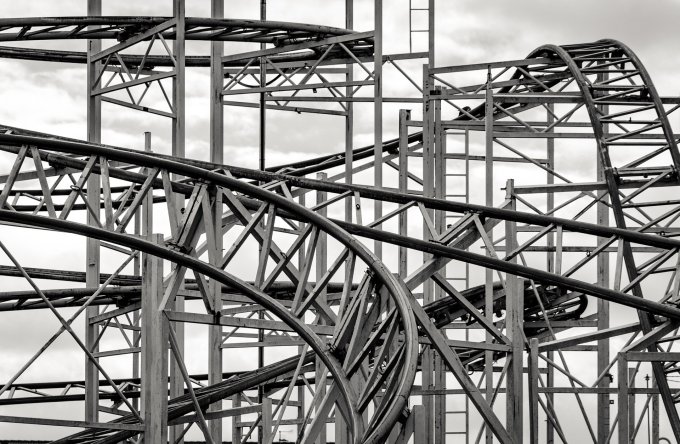
Steel in residential construction
Although steel in construction is often associated with large structures and skyscrapers, it is also finding increasing use in residential construction. From single-family homes to multi-story apartment blocks, steel offers numerous benefits that attract both investors and homeowners.
One of the main reasons for choosing steel in residential construction is its strength and resistance to forces of nature, such as earthquakes and high winds. Steel structures are more resistant to structural damage, which increases the safety of residents. In addition, steel is non-combustible, which is an additional advantage in terms of fire protection.
Steel in residentialconstruction also makes it possible to create modern, visually appealing homes that feature large spaces and open floor plans. Architects can design homes with more complex forms, with large glazed areas or minimalist finishes. Steel structures allow for large glazing, which in turn brings more natural light into the interiors, increasing living comfort.
Another advantage of steel in residential construction is its environmental friendliness. Steel is a material that can be recycled many times without losing quality, making it a more sustainable option compared to other building materials. As environmental awareness grows among the public, more and more people are opting to build environmentally friendly homes, making steel an ideal choice.
In Poland, thanks to the use of modern prefabrication technologies, the construction of steel houses is becoming increasingly popular. Prefabricated steel elements enable fast and efficient construction, reducing construction site labor time and minimizing waste. This, in turn, translates into lower construction costs and increases the availability of homes made with steel.
Finally, it is worth mentioning that steel in housing construction also contributes to supporting the local economy. Most of the steel used in Poland comes from domestic steel mills, which boosts local production and employment.
Industrial halls and steel warehouses
The use of steel in the construction of industrial halls and warehouses is not only popular, but even necessary due to the specific requirements of these facilities. Industrial halls and warehouses need large, open spaces that allow the free movement of equipment, goods and ensure operational efficiency.
Steel in industrial hallconstruction offers numerous advantages. First and foremost, it allows projects to be completed quickly thanks to prefabricated steel components that are easy to install and do not require lengthy assembly work. Second, steel structures are extremely strong and can carry heavy loads, which is crucial in the context of warehouses where heavy goods are often stored.
The ability to design large, column-free spaces is another advantage of steel in this type of building. Such a solution facilitates the organization of space and increases its flexibility in the context of changing business needs. In Poland, where industry and logistics play an important role in the economy, steel structures are widely used in production halls, distribution centers and warehouses.
Durability and low maintenance costs are other reasons why steel in construction is often chosen for industrial halls and warehouses. Steel structures are more resistant to weathering and corrosion, especially when properly protected with anti-corrosion coatings. The longevity of steel makes the operating costs of such buildings lower compared to other building materials, which is an important factor for businesses.
It is also worth noting that the use of steel in industrial halls and warehouses promotes flexible building expansion. Steel structures can be easily adapted to new production or storage needs, which is important in dynamically changing market conditions.
Ecology and sustainability are other aspects that support the use of steel in this category of buildings. The ability to reuse and recycle steel makes it possible for steel halls and warehouses to be part of a company's sustainability strategy, while meeting increasingly stringent environmental standards.
Polish construction and engineering companies, such as Mostostal, have already gained extensive experience in the design and construction of steel industrial halls and warehouses. As a result, they are able to deliver high-quality, durable and functional solutions that contribute to the development of the local economy and increase the international competitiveness of Polish companies.
Summary
Steel in construction is an extremely broad and important topic, covering many aspects of modern construction design and implementation. From residential and commercial buildings to bridges, viaducts and industrial halls and warehouses, steel plays a key role due to its strength, flexibility, durability and adaptability to changing needs.
In Poland, the growing interest in steel in the construction industry is clearly visible, with local manufacturers and constructors at the forefront of the industry. Thanks to advanced manufacturing and prefabrication technologies, steel makes it possible to construct buildings quickly and economically, while reducing the negative impact on the environment.
The benefits of using steel in construction are undeniable: the ability to create unique, modern architectural designs, increased safety, fast construction and low maintenance costs. Ecology, sustainability and material recycling put steel in an even better light, making it the material of the future in every branch of construction.
Regardless of the specifics of a project, steel in construction is a reliable and versatile material that, thanks to its reliability and versatility, will undoubtedly remain the foundation of modern structures for many years to come. Against the backdrop of continued technological development and growing environmental challenges, steel will continue to play a key role in shaping the future of construction in Poland and around the world.


